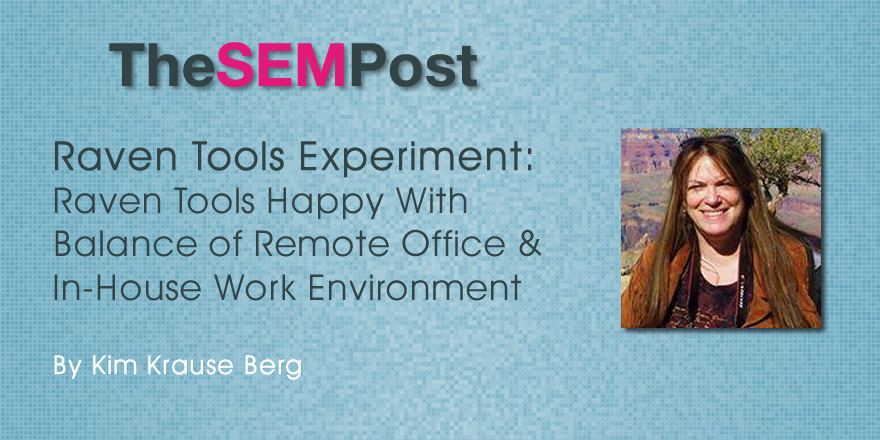 Jon Henshaw, Co-Founder & President of Raven Internet Marketing Tools, struck a nerve when he wrote an article on working remotely which he shared on LinkedIn.
Jon Henshaw, Co-Founder & President of Raven Internet Marketing Tools, struck a nerve when he wrote an article on working remotely which he shared on LinkedIn.
“We had six months to find a new office,” wrote Henshaw in his popular piece, The incredible thing that happened after we lost our office.
What happens when an entire company has nowhere to go for a month?
When the perfect, new Nashville, TN location was settled on, there was a month’s lull in between. Not counting the monumental hurdles already facing a leading SEO software tools company, where countless customers depend on their marketing software to work even if the sky is falling, how does a company hold it together when everyone is everywhere?
You prepare for the sky to fall.
Henshaw described their experience in his story. “Since we had a few weeks’ notice, we started preparing by having people work from home and look for co-working spaces. We also got serious about our use of Google Hangouts for meetings. My business partner, Scott Holdren, struck a deal with Bar Louie – a restaurant and bar in The Gulch and a popular lunchtime spot for us – to use their private room every Wednesday. That provided a space for facetime, and it maintained our weekly company lunch that we typically did on Thursdays at the office.”
They survived and made a Zen-like discovery that comes from the center of chaos. Telecommuting did not destroy Raven Tools. In fact, thanks to its open-minded leadership, who were unafraid of taking risks, “Nothing really changed.”
Many Experts Work From Home
According to GlobalWorkplaceAnalytics.com data from 2014, 3.7 million employees (2.5% of the workforce) now work from home at least half the time in the USA. That number continues to rise, despite resistance from some companies, but for certain types of industries, remote work is feasible and even desirable.
As both a consultant and telecommuter, I’ve tested web based software applications remotely for many years. Several times during my career I rejected dream job positions because I refused to re-locate and move my kids away from their father and my step-son away from his mother. These companies would not consider telecommuting, even when they came looking for me specifically for my skills.
In speaking with people in preparation for this article, choosing remote work or freelance consulting from home is motivated by the lack of job security, layoffs and downsizing. There is no such thing as pension and the gold watch for your years of service. If you prefer to work without daily managerial interference, telecommuting is considered a pleasant experience.
Some people shared experiences with companies that micro-manage their employees, and management with trust issues. If they can’t see their employees, they don’t believe they are doing their jobs. Corporate level management not accustomed to using the Web are unable to wrap their heads around the idea of any employee performing well outside of the cube farm.
There are exceptions of course. When I was laid off from my job as a QA Software Usability Engineer in 2001, I was hired 6 hours later by a company contracted to AT&T WorldNet needing software testing and knew I could do it from home. To prevent me from considering working in-house for any other company, they even asked me to name my salary. I saw the owner once. It was to introduce me to our boss, who was very impressed and wanted to meet the woman making their software purr.
 Jon Henshaw hit a nerve. Because since that experience, I’ve experienced a noticeable resistance to remote workers, consultants and telecommuters. As I researched for this article I was not surprised to learn that most people don’t wish to share that they work from home in sweat pants because they fear their reputation will suffer for it.
Jon Henshaw hit a nerve. Because since that experience, I’ve experienced a noticeable resistance to remote workers, consultants and telecommuters. As I researched for this article I was not surprised to learn that most people don’t wish to share that they work from home in sweat pants because they fear their reputation will suffer for it.
Business as Usual
Kim: You wrote: “For the most part, it’s been business as usual, and we’ve stayed on schedule with our projects. In fact, a few people have expressed how happy they feel now that they get to work from home. Some have said they were able to focus more and they gained more time by not having to do a long commute every day.” What part(s) are not “business as usual”?
Jon: “When everyone was required to be in the office, it was easy to walk over to a colleague’s desk to discuss an issue face to face. However, with everyone being remote, we’ve had to adjust and rely even more on Slack for daily communication and Google Hangouts for face to face chats.
Other than that, it really has been business as usual.”
In fact, there are a slew of online tools remote workers use to help them communicate and “be” in the office. Skype and Google Hangouts allow face to face meetings. Web-based software, Joinme, allows two computers to connect with one shared screen so that a project can be discussed with one person providing instruction or demonstrations from their computer. Instant Messaging is popular, even for in-house employees. (And abused too. Just ask anyone who gets messages and emails from the person sitting next to them.)
Employee Health and Safety
Work-at-home employees, among the non-self-employed population, has grown by 103% since 2005 and 6.5% in 2014, according to findings from globalworkplaceanalytics.com.
There is a famous search engine marketing company based in a city near me. It is owned by someone who has grown his company while managing to keep his staff happy. His work ethic is outstanding. I would work for that company in a heartbeat, but the area has grown so populated that getting there not only takes up to 2 hours one way due to the traffic, but on bad weather days, the commute by automobile or train isn’t safe or reliable. Employment agencies have a difficult time finding opportunities for those who wish to work from their home offices.
Ask anyone who commutes an hour or more into the office how they feel emotionally, mentally and physically. They are more likely to feel anxious. They may risk their life driving in the snow to get to work. They have less time to spend with their families and are less likely to be involved with school activities. To be able to go to the dentist or doctor is a struggle because they need to take a sick day to do it or they must use their own sick or personal days to take care of their own sick children, forcing them to come to work feeling ill.
Remote workers have more flexibility. They are often better able to adjust their hours, and many out perform their in-house team mates. They can work at home and take care of a sick child.
Kim: “Did that “happy” translate to better production? Have you thought about mental/emotional employee health and productivity?”
Jon: “It’s too soon to tell if “happy” also means more productive. My main concern would be if people started to become less productive, but fortunately, there doesn’t seem to be any sign of that. On a basic human level, it makes me happy knowing my employees are happier. From a business perspective, I believe that happier workers will be more dedicated and loyal to the company.”
An environmentally aware company finds ways to conduct business while reducing its impact on the planet. Some of my conversations were thoughtful observations about these concerns and a desire to stop contributing to corporate greed.
“Environmentally friendly business practices have become commonplace over the last decade, and the technology sector is no exception. With organizations like Gartner and publications like E-Commerce Times listing Green IT among their top trends for 2008, many people may be wondering what they can do to make their technology usage more environmentally friendly.” – Could broadband help the environment?
Telecommuting is Not Always Feasible
Telecommuting is not for everyone. Some people need the more social aspects of an office environment. Perhaps the office is quieter than home or too quiet and lonely.
Kim: “Was there any difference in the responses from employees who are single vs parents, long commute vs shorter?”
Jon: “I’ve found that it really depends on their personality instead of whether they are single or parents. However, parents by and large — and this includes myself — prefer to not work at home. Everyone I’ve talked to found their kids to be distracting.”
As a work from home mother, the kids were taught to not interrupt or be quiet at certain times. I was also able to attend every after school sport, be President of the Football Booster Club, maintain the elementary school website I built, and moderate the Facebook pages for their school teams because my hours were flexible.
However, two stories from mothers who worked from home with young children stick in my mind. One is from an SEO mom who hid in the closet during client calls because it was quieter there. The other was from the mom who had cabin fever one winter so badly that she threw the kids in the mini-van and drove to the end of her driveway and back just to get out of the house.
Alternatively, sometimes it’s the office environment that is the source of distractions, as described by someone at Cre8asiteforums, who wrote, “In an office setting, there are a lot of disruptions that can derail your concentration and flow.”
If you choose to telecommute, it takes creativity, discipline and a sense of humor.
Employee Retention and Loyalty
Many IT companies go outside the country to hire staff, but refuse to allow telecommuting for their employees at home. Progressive companies recognize that their employees spend a great deal of time on site and provide incentives to reduce their healthcare costs by encouraging employees to use the gym or offer discounts on facilities used by remote workers who also work long hours.
Kim: “You wrote: ‘Moving forward, we’re going to embrace a hybrid working environment that fits the needs and desires of our employees.’ – Key here is “needs and desires of our employees”. That’s new thinking. It makes me think your management listens to its employees and are not afraid to make changes that benefit them.
Tell me about company morale, employee loyalty, and employee retention. Is it too early to see any difference or did it smack you in the head immediately? Has your recent experience created this new thinking or is it the result of existing management styles or simply a wakeup call on the order of trial by fire?”
Jon: “We haven’t always been as open to making these type of changes, but there was a major shift in management that happened at the beginning of 2015 that acted as a catalyst towards this type of thinking. Looking back over the last year, we have definitely had a higher level of loyalty as very few people have left the company on their own accord during that time. This change to a hybrid work environment has also positively affected morale. However, there are many other things we do for our employees that affect that too, like buying the office lunch every week and providing generous PTO and excellent healthcare benefits.
I feel the biggest difference with this recent change is that I’ve had more employees go out of their way to tell me how much happier they are now.”
Jon’s article on LinkedIn received 85 thumbs up and 28 comments. Rae Hoffman, CEO of PushFire, is an award winning affiliate marketer since 1998. She described her experiences as a company owner and finding talent. She rightly points out that remote hiring allows companies to bring in the best of the best.
If your most highly skilled staff commute into the office every day, what are they sacrificing for you? By allowing a 2 day work from home option, productivity, loyalty and employee retention increase.
The Harvard Business Review ran an article on a case study called, To Raise Productivity, Let More Employees Work from Home. They concluded with this.
“Half the volunteers were allowed to telecommute; the rest remained in the office as a control group. Survey responses and performance data collected at the conclusion of the study revealed that, in comparison with the employees who came into the office, the at-home workers were not only happier and less likely to quit but also more productive. It’s in middle management where there’s resistance.”
I asked for comments on telecommuting on my Facebook page and in a discussion at Cre8asiteforums, where I am the Administrator. The responses I received from people there, and off-line, covered office politics, close minded management, unskilled managers making ill informed decisions that drove away employees, and a “low tolerance for BS”. There are remote workers who are not allowed to tell anyone they work from a home office because there is a fear they may be perceived as less professional.
I asked if anyone would consider a pay cut for the chance to telecommute and the response was an overwhelming “No” since they are paying for their own electricity, and in many cases, their own computers, software, Internet, phones, etc.
The Future for Remote Workers
If you are late to the idea of remote workers, you may be missing out on opportunities such as providing services for telecommuters like home delivery of food and pharmacy items. The future is here.
“We are looking into the future here, so let’s imagine the possibilities: Service jobs staffed by freelance workers from across the globe. Location eliminating itself as a barrier to entry; a teen from rural Missouri could end up taking orders at a McDonalds in San Francisco. (If you think that sounds implausible, remember that we’re already doing that at some fast-food drive-thru stations, where the people who take your order operate out of a remote call center.) (Snip) Or, to borrow from John Scalzi’s original idea, where people with disabilities or chronic illnesses use Beam to navigate the world while remaining at home.” – A New Way to Work from Home: Telecommute Into a Robot Body
Everyone who telecommutes has their own work habits, company rules and even health requirements. Remote work allows handicapped and special needs people to have good paying jobs. Pets don’t need to be shoved into a crate all day. You can make your own food. There are no production-blocking meetings that chip away at the day. Nobody will come to work sick, putting you at risk. In one study I found, 80% to 90% of the US workforce says they would like to work from home at least part time.
“I would not have accomplished a fraction of what I have in the past 15 years without the telecommuting efforts of myriad professionals on contract.” – iamlost, Cre8asiteforums
Obviously not all companies conduct the type of business that allows for remote employees. However, this is an age where computers, software and mobile devices connect our homes and businesses, even our vehicles. Advances in technology break down barriers. Online marketers, web designers, and software developers are more likely to be capable of setting up shared servers and secure connections. Airports have added more outlets and charging stations, and hotels know that people work from their hotel rooms. How many of you who speak at search engine marketing conferences put together your Power Point presentations in your hotel room the night before your talk?
Kim: “Imagine you are on the Ted stage sharing the experiences from Raven. How would you convince other companies to try remote work options?”
Jon: “I’m not sure if I could tell a story that would convince other companies to try remote working just yet. Most businesses only care about the bottom line. Whereas my business partner and I care about the bottom line and quality of life (and not just our own quality of life). Perhaps over time, if this change results in our company providing a better service and causes significant revenue growth, I’ll be able to weave a story that will compel even the most skeptical of business owners.”
Happy employees create better products.
Resources Used For This Article
Main Report: The Broadband Difference
Could broadband help the environment?
How Americans are – and aren’t – making eco-friendly lifestyle changes
A New Way to Work From Home: Telecommute Into a Robot Body
Telecommuting…remote Work…do you orDon’t you? Love or Dislike?
The incredible thing that happened after we lost our office
Kim Krause Berg
Latest posts by Kim Krause Berg (see all)
- Test Driving Google’s Accessibility Apps & Tools for Android - April 14, 2016
- Raven Tools Happy With Balance of Remote Office and In-House Work Environment - February 17, 2016
- Why Accessibility Will Matter More in 2016 and Beyond - January 12, 2016
- SEO is Not Part of Website Development? Really? - November 19, 2015
- Mobile Testing Beyond Google’s Responsive Web Design Test Requirements - June 8, 2015



Sam says
Great article. In our company, we have emergency work-from-home (WFH) plan and we are required to re-check how we’re prepared, on monthly basis. For example, we shouldn’t have critical resources stored locally, etc.
Kim Krause Berg says
Thank you! I have begun planning Part 2 on this topic, due to the responses I’ve received and interest . Anyone wishing to share their experiences, company policies, etc. can use the contact form on my site – creativevisionwebconsulting.com.